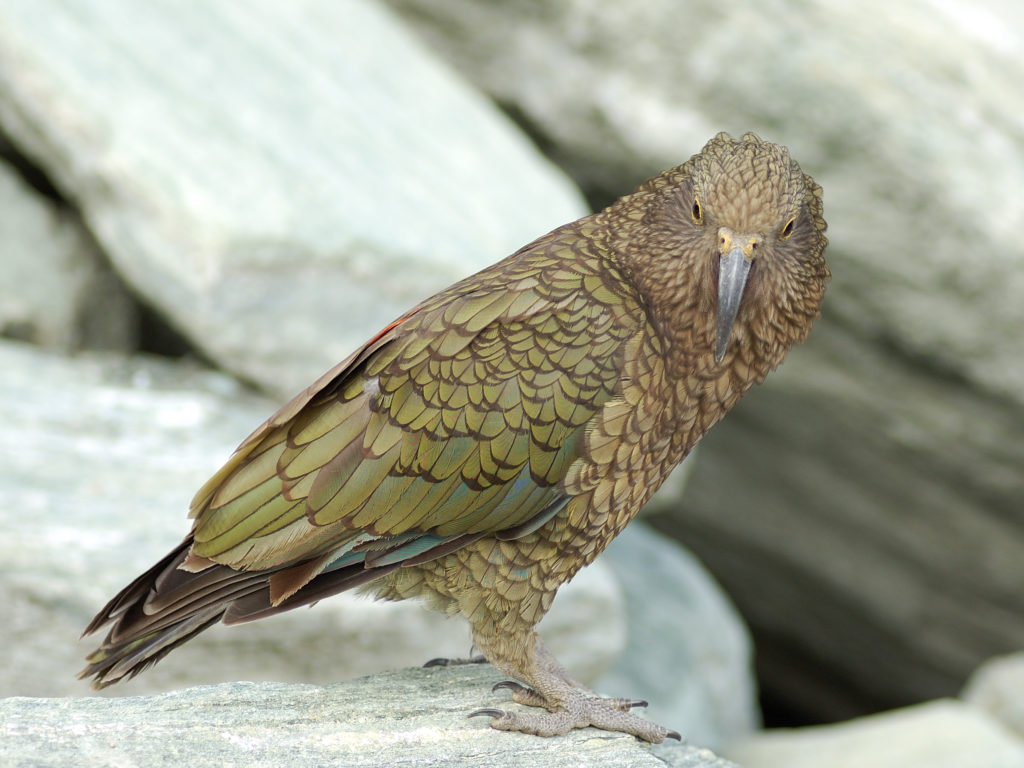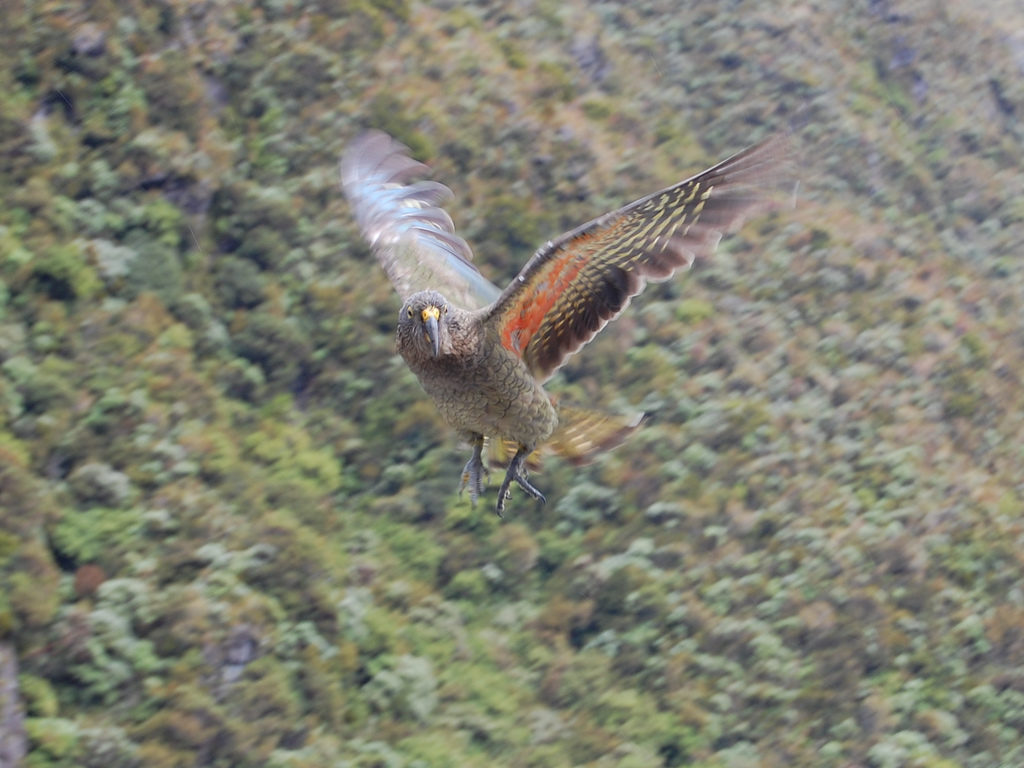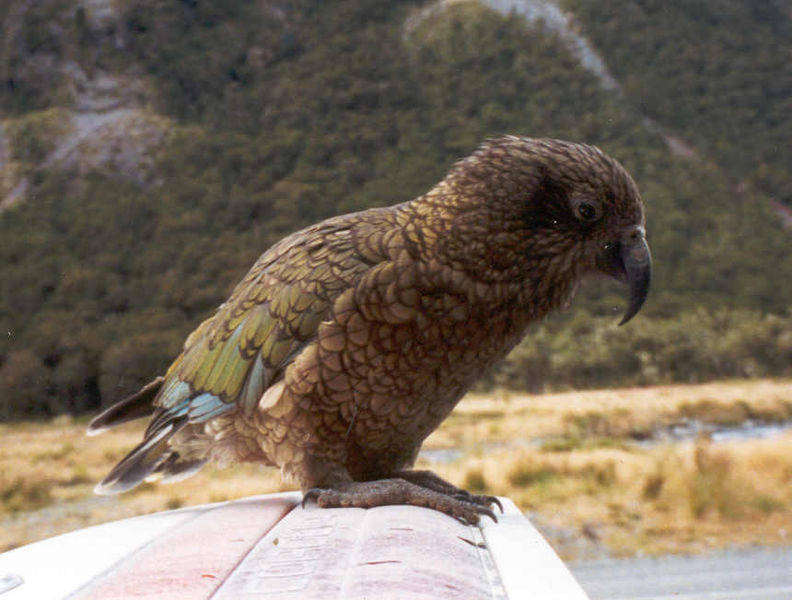Predator control in kea habitat is mostly by aerial 1080 – and some kea are known to have died from eating the bait. It’s not an outcome that anyone wants to see.
So what are the risk factors? What might be done to mitigate those risks and why do leading conservationists, including kea experts, think that aerial 1080 operations should continue?

A paper just published in the New Zealand Journal of Ecology looks at kea survival during aerial poisoning of rats and possums and follows the fates of monitored kea over multiple 1080 operations.
“Understanding the net effect of aerial 1080 for native species is of considerable conservation importance in New Zealand because it is one of few proven pest control methods that can be applied on a large scale in rugged terrain at reasonable cost and because of public interest in the method.”
For the record, poisoned carrots are no longer used and haven’t been used for many years. Methods have improved significantly, but we still have more to learn. Some kea do still die.
“Aerial 1080 baits are cereal-based pellets, weighing 6 g or 12 g, with a field life ranging from a few days to a few weeks depending on rainfall. Poison pellets contain 1.5 mg of 1080 toxin per gram of pellet. The pellets are flung from a hopper slung under a helicopter at coverage rates of 1–3 kg per hectare. Most pellets fall to the ground, where they lie until they are consumed by animals or degraded by moisture.”
Kea are spread out over a huge area of the South Island backcountry – it simply isn’t possible to cover all that area with traps. If fact, kea interfere with traps too – sometimes with fatal consequences.

“Kea are sparsely distributed across about three million hectares of indigenous South Island forests and about 1.5 million hectares of adjoining sub-alpine shrublands, grasslands and herbfields. Nearly all of the kea’s range is legally-protected montane wilderness, administered by the New Zealand Department of Conservation (DOC).”
Much of that landscape has been part of at least one 1080 operation in recent years.
“Roughly one-third (c. 27%) of the kea species range had aerial 1080 applied between 2014 and 2016. Pest control campaigns in 2014 and 2016 saw an unprecedented 554 000 ha and 729 000 ha, respectively, treated with aerially applied 1080 baits.”
It’s the kea’s well-known intelligence and curiosity that puts them at risk from 1080 operations. They’re not necessarily hungry or keen cereal eaters, but they’re clever, adaptable and omnivorous – and they tend to feed on the ground where most baits are to be found.
“These traits potentially put kea at risk of poisoning during vertebrate pest poisoning operations. However, as kea fall prey to introduced pests, they also gain from pest control, creating a cost-benefit situation. Understanding the net outcome for kea of this pest control method is extremely important because kea are endangered and aerial 1080 use is controversial. We use 222 monitoring cases of individually marked kea at 19 aerial 1080 operations to model kea survival of aerial 1080 operations.”
The research was carried out between 2008 and 2016 for 19 operations at 12 different sites. Kea survival was monitored with respect to 5 variables:
“Specifically, we investigated whether 1080 poisoning risk was:
- higher close to scrounging sites
- lower after repeated aerial 1080 treatments (i.e. at sites where aerial 1080 had been previously applied)
- higher with larger bait size
- lower for adult kea than juvenile kea
- different for males and females.”
Whether prefeeding increased risk to kea could not be evaluated because all aerial 1080 operations in the study used prefeed.

One of those risk factors is something we can all do something about – feeding kea or allowing them to scrounge human food potentially encourages them to try new foods – and may make them less cautious about investigating 1080 pellets. The research results suggest this is a very real risk.
“Proximity to human-occupied sites where kea scrounge human food was inversely related to survival; the odds of survival increased by a factor of 6.9 for remote kea compared to those that lived near scrounging sites. High survival in remote areas is explained by innate neophobia (fear of new things) and a short field-life of prefeed baits, which together preclude acceptance of poison baits as familiar food. Elevated risk to kea living near scrounging sites is explained by learned neophilia (love of new things), possibly exacerbated by lead poisoning.”
The second variable tested was whether survival differed at sites where 1080 had been dropped previously.
“Survival was also related to the history of aerial 1080 treatment at a site; the odds of survival increased by a factor of 21.3 at sites with repeated operations compared with first time treatments. This effect is possibly due to selection for neophobic phenotypes.”
In other words, the more cautious birds survived the earlier operations and continued to be cautious, possibly passing that caution on to their offspring.
So how many of those 222 kea died in those 19 aerial 1080 operations and what might be done about it?
“We recorded 24 kea deaths, all within six operations. Poison-pellet cereal matter present in the digestive tracts of all necropsied corpses (n = 17) indicated that primary poisoning was the cause of death. Necropsies were not conducted in seven cases owing to advanced decomposition that resulted from logistical delays retrieving corpses from the field. The seven deaths were considered for the study as due to 1080 poisoning.”

Kea living at remote locations away from human food sources and where 1080 had been dropped previously, were considerably less likely to die.
“With only one death out of 60 remote monitoring occasions in repeated operations, the lower 95% confidence limit for kea survival in this context is 95.6%. Given the high magnitude of benefits from predator control measured for kea and other species with similar nesting ecology, such as kākā and whio, we expect to see strong kea population growth resulting from long term aerial 1080 programmes in remote areas.”
So what can we, as individuals do to help the kea that live near humans? Don’t feed them – and let’s make sure that visitors to New Zealand know not to feed them too.
“We suggest that 1080 poisoning risk management for kea should focus on reducing human food availability through an advocacy campaign. If most kea have not been fed by humans, then the longterm outcome of the South Island aerial 1080 programme should be positive for the kea.”
“In summary, we are confident that aerial 1080 application is not cause for concern for kea in repeated aerial 1080 operations at remote sites, particularly when the operations are designed to maximise predator control benefits to kea, as risk to kea is easily offset by these benefits. Proximity to scrounging sites is strongly associated with elevated 1080 poisoning risk, but this risk is not well quantified.”
The researchers conclude with 4 recommendations:
“We recommend:
- the implementation of a scrounge-management programme,
- research to improve our understanding of the links between scrounging, neophobia and 1080 poisoning risk,
- further measurement of risk to young kea, and
- further measurement of risk at first treatments in remote sites. If the South Island aerial 1080 programme comprises mostly remote repeated operations, then a positive longterm net outcome for kea is likely.”
This full research report is published in the New Zealand Journal of Ecology and is freely available online.
Kea survival during aerial poisoning for rat and possum control (2019)

